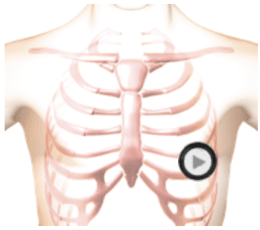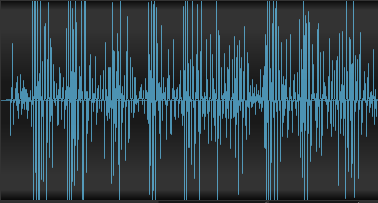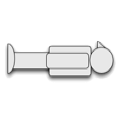This is a recordinng of third heart sounds occuring early in diastole. In young people and athletes it is a normal phenomenon. In older individuals it indicates the presence of congestive heart failure.
The third heart sound is caused by a sudden deceleration of blood flow into the left ventricle from the left atrium. In the anatomy video you will see a thin-walled, dilated left ventricle with generalized decreased vigor of contraction.
In the presence of a third heart sound (S3) the first heart sound is decreased in intensity while the second heart sound is increased in intensity.
The third heart sound is a low frequency sound best heard with the bell of the stethoscope pressed lightly on the skin of the chest.
Third Heart Sound Gallop 106 Audio


Third Heart Sound Gallop 106 Sounds


Half Speed Third Heart Sound Gallop 106 Sounds


Technique

The patient's position should be supine.
Auscultation Tips for Third Heart Sound Gallop 106
S1:Reduced intensityS2:Increased intensity
Diastole:S3 early in diastole, low-pitched, heard during expiration
Sound Wave
Third Heart Sound Gallop 106 Video
Authors and Sources
Authors and Reviewers
- ECG heart rhythm modules: Thomas O'Brien.
- ECG monitor simulation developer: Steve Collmann
-
12 Lead Course: Dr. Michael Mazzini, MD.
- Spanish language ECG: Breena R. Taira, MD, MPH
- Medical review: Dr. Jonathan Keroes, MD
- Medical review: Dr. Pedro Azevedo, MD, Cardiology
- Last Update: 11/8/2021
Sources
-
Electrocardiography for Healthcare Professionals, 6th Edition
Kathryn Booth and Thomas O'Brien
ISBN10: 1265013470, ISBN13: 9781265013479
McGraw Hill, 2023 -
Rapid Interpretation of EKG's, Sixth Edition
Dale Dublin
Cover Publishing Company -
EKG Reference Guide
EKG.Academy -
12 Lead EKG for Nurses: Simple Steps to Interpret Rhythms, Arrhythmias, Blocks, Hypertrophy, Infarcts, & Cardiac Drugs
Aaron Reed
Create Space Independent Publishing -
Heart Sounds and Murmurs: A Practical Guide with Audio CD-ROM 3rd Edition
Elsevier-Health Sciences Division
Barbara A. Erickson, PhD, RN, CCRN -
The Virtual Cardiac Patient: A Multimedia Guide to Heart Sounds, Murmurs, EKG
Jonathan Keroes, David Lieberman
Publisher: Lippincott Williams & Wilkin)
ISBN-10: 0781784425; ISBN-13: 978-0781784429 - Project Semilla, UCLA Emergency Medicine, EKG Training Breena R. Taira, MD, MPH
-
ECG Reference Guide
PracticalClinicalSkills.com
Third Heart Sound Gallop 106 | Auscultation Cheat Sheet with Sounds & Video | #84